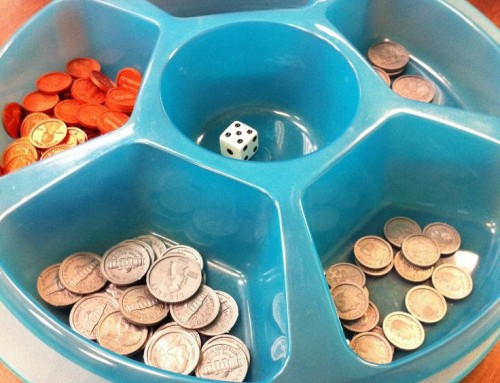Shortening The Money Game
I often get calls from people who want to know if they can use The Money Game in a shorter time frame, like two hours or less. This is a great question, and depending on the group that you’re teaching, sometimes the answer is “Yes”, sometimes the answer is “Maybe” and sometimes the answer is “Nope.” Let me give you some guidelines on teaching a shorter version of The Money Game.
The first things to keep in mind are the following:
- The more students in the game, the longer each round, and hence the game, takes.
- The younger the students, the longer each round and the game takes.
- The fewer volunteers you have helping you help the students will out their registers, the longer each round and the game takes.
- If you purchased, and invested in, the Extra Activities, or want to add in the free extra activities that come with the game, you’ll be extending the playing time of the game AND adding to the student’s knowledge base in total.
Also, in order to shorten the game, you must keep in mind the main objective of the game as follows:
 Get the students to the point where they have the ‘financial freedom ah-ha’, i.e., they understand the following principle…
Get the students to the point where they have the ‘financial freedom ah-ha’, i.e., they understand the following principle…
“To win your own personal Money Game, the regular Passive Income (cash flow) from your Assets is greater than the Expenses of your Chosen Lifestyle.”
In other words, if you’re renting a room from someone and living simply and your monthly expenses are $1500, you need to have MORE than $1500 in passive income from the money you’ve invested in assets in order to work because you WANT to, not because you HAVE to.
If, on the other hand, you want to live in a huge home, have two new cars, send two children to private school, and taking big, expensive vacations every year and your monthly expenses are $10,000, you need to have enough regular passive income over more than that to be financially free.
Adjustments you can make to shorten The Money Game
Keeping everything above in mind, and assuming you’ve gone through The Money Game Instruction Manual as well as watched the Money Game Teacher Training Videos, you know that the students have the opportunity in a normal game (6-8 hours) to invest in their first asset in Round Four. This means they learn about, and receive, their first $100 of Passive Income beginning Round Five.
You probably also have a good sense that sometimes it takes a few more rounds before any of your “reluctant to invest” students see all of the fun others are having and decide to join in.
Note: occasionally you will have a student who has been around too many adults who have said, in their presence, how terrible investing is, that they should never invest in real estate or the stock market or how much work starting your own business is. Don’t try to change their minds about these things…simply let them play and in time, you may be surprised that their beliefs change bit by bit. And if they don’t, it’s OK, too. You’re not there to make sure every child gets it…some just won’t and there’s nothing you can do about it.
So depending on how many students and their ages, and the addition of any extra activities, it could take from two to three (or more) hours to get to Round Four and Five and then do a quick Debrief (where you talk about what they learned in a lesson or playing the game) on your flip chart where you explain how they become financially free.
Here are the few adjustments that we’ve found you can implement to shorten the game…
First off, do the Setup Activity with one volunteer instead of the whole class/group. While it’s not quite so much fun, the students still learn the lessons and you can make it very playful by having them cheer on the volunteer and ask the group the same questions that you ask the volunteer.
- After Round One, when you introduce Pay Yourself First, surprise them with the Event Card that eliminates their Car Payment Expense. Feel free to ask them questions such as, “How can you have no car payment?” “What can you do with the extra $100 now?”
- This provides an extra $100 they can Pay Themselves First with so you can actually introduce investing in Assets in Round Three instead of Round Four.
- After Round Two or Three, you can then surprise them with the Event Card that removes their Credit Card Expense. They now have $200 extra from their paycheck to Pay Themselves First.
- Now, because Assets cost $300 each, they can invest in them sooner and they start getting Passive Income sooner.
- Lastly, you can give them $200 in Passive Income for every Asset they have invested in. Their monthly expenses are now $700 (because you have removed the Credit Card Payment and Car Payment), as long as they don’t buy Piddlyjunk and they can technically be financially free with four assets.
This method does make some adjustments necessary with pieces of some of the rounds. For example, the car insurance lesson which happens after Round Three, where they learn not to let their accounts go down to $0, doesn’t work because they ‘should’ have enough money in their game envelope (savings account) to pay their deductible. What you can do is move the Car Accident after Round Two instead of Round Three or even do it after Round One. Try it both ways to see which way you like it best.
OK, so this should help get you started on teaching The Money Game in a shorter format program. We like to say it takes a minimum of three hours to get to the Financial Freedom Ah-Ha moment but you can get there a little faster depending on how you run the game.
If you come up with other great ideas, on shortening the game, lengthening the game, altering the game, etc. please post your comments below or send me an email and I’ll write it up and send it to all of our amazing The Money Game™ instructors.
Have fun empowering your students. The quality of their lives depends on it.




Leave A Comment